令和5年11月11日 土曜日号
“青花 令和3年”

ツユクサの別のよび方だが
ツユクサからとった青色の染料の
こともさす
その染料で絞りや友禅の
下描きを染める
これは出来上った時には
消えてなくなるもので
縁の下の力持ちの役割をしている
(脇阪 克二)
Aobana/ Dayflower (2021, by Katsuji Wakisaka)
Aobana is another way of saying "dayflower",
and it also refers to the blue dye derived from dayflowers.
The pigment is used to dye the rough sketches in tie dye or yuzen dyeing.
Since the dye will disappear from the finished product,
it is acting as an unsung hero.
| English translation by Lala Fu |
Fleur bleue (2021 par Katsuji Wakisaka)
La comméline est l’autre nom de cette fleur
dont on extrait également un colorant bleu.
Cette couleur était très utilisé dans plusieurs techniques
de teintures japonaises comme le shibori ou le yuzen
pour dessiner l’esquisse d’un motif.
Bien que ce trait disparaisse
une fois l’oeuvre terminée,
il joue un rôle indispensable.
| Traduction francaise par JB&B |
青花 (2021, 脇阪 克二)
青花是鴨拓草的別名
也代表從鴨拓草中萃取出的藍色染料
該染料用於紮染或友禪染的草稿刷色和描繪
由於它的顏色會在成品上消失
可說是默默奉獻的無名英雄
| 中譯 : 莊 幃婷 |
→こちらのテキスタイルデザイン商品
(Textile products with this pattern)
令和5年11月08日 水曜日号
“装飾金具 令和4年”

お城やお寺などの門を
しっかり固定するために
金具が使われている
がっちりと作られた機能的な
ものだが 装飾としても美しく
威厳がある
それらの金具の持つ独特の形を
ふまえて 作った文様
(脇阪 克二)
Decorative Metal Fittings (2022, by Katsuji Wakisaka)
Metal fittings are used to hold the doors of castles or temples firmly in place.
They are not only sturdy and functional
but also serve as beautiful and majestic decorations.
This motif was created based on the unique shapes of these metal fittings.
| English translation by Lala Fu |
Ferrures décoratives (2022 par Katsuji Wakisaka)
Pour fixer de façon durable
les portes des châteaux ou des temples,
des charnières métalliques étaient utilisées.
En plus d’être robustes et fonctionnelles,
elles étaient aussi richement décorées.
J’ai créé ce motif en m’inspirant
de leurs formes uniques.
| Traduction francaise par JB&B |
裝飾金具 (2022, 脇阪 克二)
金具是用來牢牢固定城堡和寺廟等大門
的金屬配件
製作嚴謹 不僅具備功能性
作為裝飾也非常美觀
並能營造威嚴與莊重感
這是根據金具的獨特造型
製作而成的圖案
| 中譯 : 莊 幃婷 |
→こちらのテキスタイルデザイン商品
(Textile products with this pattern)
令和5年11月04日 土曜日号
“刃 令和2年”

刀鍛冶によって 精魂込めて
作られた刃
切れ味はもちろんだが より美しく
独自のものを作ろうと技を競い合った
日本の職人の 芸術的感性の
高さが伝わってくる
又 刃は刀の表面に見える
波形の文様をも意味している
(脇阪 克二)
Yaiba/ Blade (2020, by Katsuji Wakisaka)
According to knife craftsmen, working on a knife with all the soul does
not only result in sharp cutting edges,
but it is also a competition between craftsmen in the pursuit of
making more beautiful and authentic knives.
It expresses the high level of artistic sensibility of the craftsmen in Japan.
Besides, the word "yaiba" also means the wavy pattern
which can be seen from the sides of the blade.
| English translation by Lala Fu |
Lame (2020 par Katsuji Wakisaka)
Pour le forgeron, dans une lame qui est fabriquée
en y mettant tout son coeur,
il y a bien sûr le tranchant, mais aussi la beauté.
Chaque artisan rivalise de compétences
pour créer quelque chose d’unique.
Ils y transmettent leur grande sensibilité artistique.
De plus, les stries visibles en forme d’ondes
sur le côté de la lame du sabre ont également une signification.
| Traduction francaise par JB&B |
刀刃 (2020, 脇阪 克二)
由鑄刀師 注入靈魂 傾其所有
鍛造的刀刃
不僅鋒利 也為力求精美
製作者在技術上相互較量
進而打造獨一無二的作品
表現出日本職人 對藝術的高度感性
此外 刃也可代表在刀劍表面所看到的波形圖案
| 中譯 : 莊 幃婷 |
→こちらのテキスタイルデザイン商品
(Textile products with this pattern)
令和5年11月01日 水曜日号
“よろけ縞 平成16年”
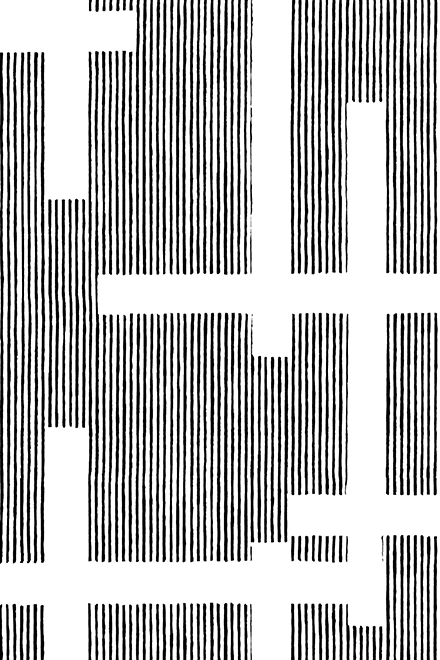
定規を使わず手書きで線を引いていく。
1本1本はよろけているが、全体としては崩れていない。
シンプルで普遍的な、自分らしさのあるデザインだと思っている。
(脇阪 克二)
Staggered Stripes (2004, by Katsuji Wakisaka)
The lines are drawn by hand, without using a ruler.
Each line is staggered, but they look neat as a whole.
I think it is a simple, universal design and
with my own personality.
| English translation by Karen Yiu |
Rayures chancelantes (2004 par Katsuji Wakisaka)
J’ai tracé des traits sans utiliser de règles.
Chaque trait oscille légèrement mais le tout reste équilibré.
Simple et universel, ce design me représente bien.
| Traduction francaise par JB&B |
交錯條紋 (2004, 脇阪 克二)
沒有用尺 直接手畫直線
每一條線都有些搖晃不平整 卻不影響整體
這是一款簡單、普遍又有自己風格的設計
| 中譯 : 莊 幃婷 |
令和5年10月28日 土曜日号
“楓ちらし 平成18年”

楓の葉がヒラヒラと舞い落ちる。
冬がそこまで来ている秋の一日。
(脇阪 克二)
Fallen Maple Leaves (2006, by Katsuji Wakisaka)
Maple leaves fluttering and falling down.
It is a day in autumn when winter is just around the corner.
| English translation by Karen Yiu |
Feuilles d’érable flottantes (2006 par Katsuji Wakisaka)
Les feuilles d’érable descendent le courant.
Une journée automnale qui annonce que
l’hiver approche à grand pas.
| Traduction francaise par JB&B |
楓葉飄飄 (2006, 脇阪 克二)
楓葉輕輕飄落。
這是一個秋天的日子,卻感受到冬天近在眼前。
| 中譯 : 莊 幃婷 |
令和5年10月25日 水曜日号
“縦横無尽 平成5年”

たて よこ ななめ と
あらゆる方向に線が走り
上になり下になり
重なりあいからみあって
模様になっている。
とらわれることなく自由自在だ。
こういうのを縦横無尽というのだろう。
(脇阪 克二)
Freely (1993, by Katsuji Wakisaka)
Lines run in every direction—
vertical, horizontal, and diagonal,
ascending and descending,
overlapping and intertwining, forming a pattern.
It is free and unrestricted, without being bound.
I suppose this is what we call "Juo Mujin"
(being unrestricted, doing things freely).
| English translation by Karen Yiu |
Librement (1993 par Katsuji Wakisaka)
Verticalement, horizontalement,
les lignes partent tous azimut.
En haut, en bas,
se chevauchent et s’enchevêtrent
pour former un motif.
De leur bon gré, à leur façon.
C’est l’image même de la liberté.
| Traduction francaise par JB&B |
自由自在 (1993, 脇阪 克二)
垂直、水平、傾斜
朝著不同方向奔走的線條
上下移動
形成重疊交織的圖案
自由自在、無所拘束
我想這就是日文中的「縱橫無盡」吧
| 中譯 : 莊 幃婷 |
令和5年10月21日 土曜日号
“がんじがらめ 平成24年”

荒い縄でしばりあげられ
がんじがらめになってしまう。
身動きがとれないし息をするのも苦しい。
もがけばもがく程しまってくる。
絶体絶命の危機。
僕はこんな目に合ったことはないが
テキスタイルデザインをつくっていて
どうしてもうまくいかないことがある。
そういう時、自分で自分を
がんじがらめにしていることがある。
自分の気持が変らないと
そこからはなかなかぬけ出せない。
がんじがらめはやっぱりつらい。
(脇阪 克二)
Tied-up (2012, by Katsuji Wakisaka)
Tied up tightly with rough ropes,
unable to move and struggling to breathe.
The more you struggle, the tighter it becomes.
A desperate and hopeless situation.
I have never been in this situation before,
but when I doing textile designs,
there are times when things just don't go well.
At those times, I find myself
tying myself up tightly in knots.
If I don't change my mind,
it is hard to get out of it.
Being tied up like this is truly painful and stressful.
| English translation by Karen Yiu |
Être pieds et poings liés (2012 par Katsuji Wakisaka)
Se sentir comme attaché,
ligoté avec une corde épaisse.
Ne plus pouvoir bouger et avoir du mal à respirer.
Lutter jusqu’à son dernier souffle,
c’est une question de vie ou de mort.
Je n’ai jamais rencontré de telles situations mais
face à mes créations, parfois,
le résultat ne fonctionne pas du tout.
Et c’est dans ces moments-là que je me sens de la sorte.
Si mon ressenti ne change pas,
c’est dur de trouver une solution
et ce sentiment d’être « ligoté » est vraiment insoutenable.
| Traduction francaise par JB&B |
五花大綁 (2012, 脇阪 克二)
粗糙的繩索交錯綁起
成了五花大綁的狀態
身體無法動彈 呼吸困難
越是掙扎 越感到痛苦
已陷入絕望的危機中
我雖從未遇過這樣的情況
但曾經在創作圖案紋樣之時
怎麼都無法順利
此時 心中會把自己捆成
五花大綁的狀態
如果不改變自身想法
就很難從中脫身
被五花大綁真的非常痛苦啊
| 中譯 : 莊 幃婷 |
→こちらのテキスタイルデザイン商品
(Textile products with this pattern)
令和5年10月18日 水曜日号
“ふくれ織 平成4年”
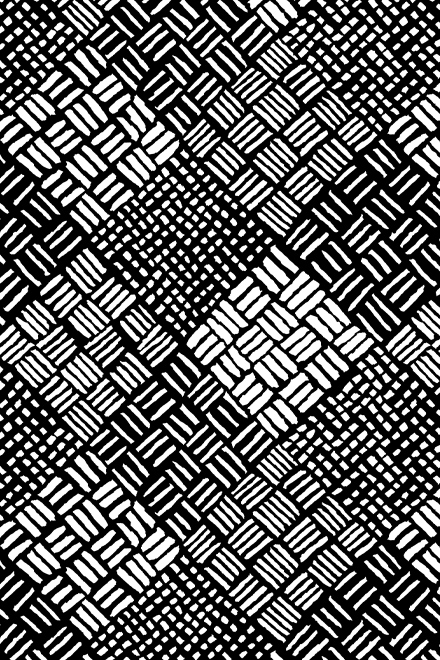
布地のある部分を立体的に盛り上げるふくれ織。
二重織の一種で複雑な行程があるようだ。
平らな部分とふくれた部分で模様をつくっていくことで独特の手触りと面白さが表現される。
このデザインは竹を編んだような模様だがふくれ織りを連想させる。
(脇阪 克二)
Tactual Weaving (1992, by Katsuji Wakisaka)
Tactual weaving is a kind of fabric with raised patterns.
It is a type of double weave
which the production process is said to be complicated.
By creating motifs with the flat and quitted parts,
it gives a unique texture and interesting expressions.
This pattern may look like braided bamboo
but it is reminiscent of tactual weaving.
| English translation by Karen Yiu |
Aspect matelassé (1992 par Katsuji Wakisaka)
Une texture bouffante qui soulève une certaine partie du tissu en relief.
Une sorte de double tissage résultant d’un processus complexe.
Une texture unique intéressante s’exprimant par un motif
composé des parties plates et bombées.
Cette conception rappelle le bambou tissé mais avec un aspect matelassé.
| Traduction francaise par JB&B |
浮雕織 (1992, 脇阪 克二)
布料有部分呈現立體狀態的浮雕織,
是需要複雜工藝的一種雙重編織。
透過平面和凸起部分來創作模樣,
表現出獨特的質感和趣味。
這個看似竹子編織的設計其實讓人聯想到浮雕織。
| 中譯 : 莊 幃婷 |
令和5年10月14日 土曜日号
“鞘 平成10年”
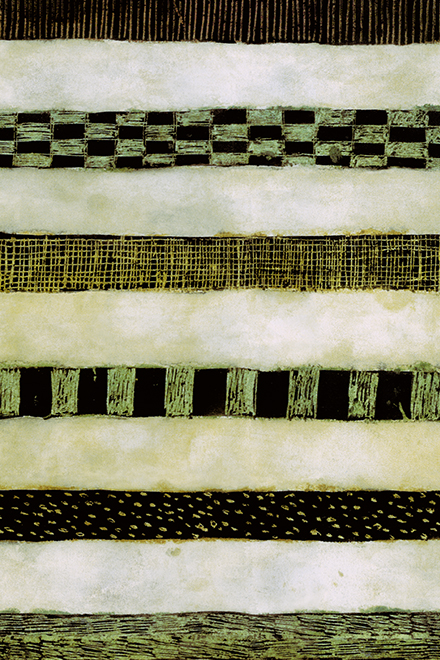
日本刀は戦う道具としてだけでは終らない
刃はもちろん、柄(つか)の部分、鍔、鞘と
技術のかぎりをつくし
想いをこめ、高い精神性と芸術性を
めざしてつくられている
日本刀には武士の魂がこめられている
(脇阪 克二)
Sheath (1998, by Katsuji Wakisaka)
The Japanese sword is more than just a tool for fighting.
The blade, of course, as well as the handle, guard, and sheath,
are all created with the utmost skill,
and is made with the aim of achieving a high level of spirituality and artistry.
The Japanese sword contains the soul of the warrior.
| English translation by Karen Yiu |
Fourreau (1998 par Katsuji Wakisaka)
Les sabres japonais ne sont pas seulement des armes de combat.
La lame, mais aussi le manche, la garde et le fourreau
sont élaborés avec un important degré de technicité,
mais également avec passion, haute spiritualité et
un grand talent artistique.
Les katanas sont imprégnés par l’esprit des samouraïs.
| Traduction francaise par JB&B |
劍鞘 (1998, 脇阪 克二)
日本刀不僅僅是用來戰鬥的武器
除了刀刃之外,刀柄、刀鄂和刀鞘等
都使用了最精湛的技術
並以崇高的精神性和藝術性為目標來製作
日本刀蘊含著武士的精神
| 中譯 : 莊 幃婷 |
令和5年10月11日 水曜日号
“みんな 令和4年”
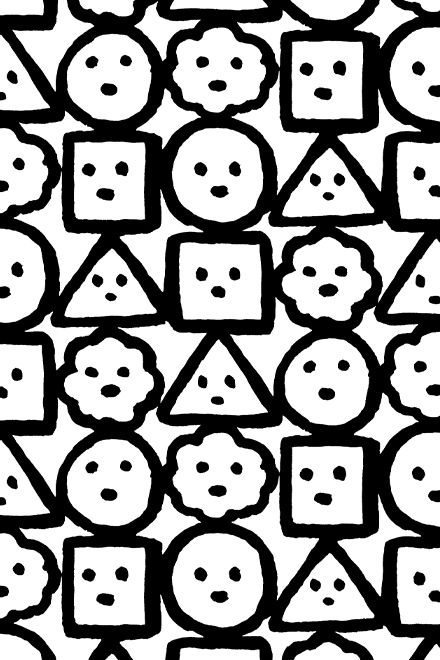
いろんな形をした顔の人が
ずらっと並んで
楽しそうに ほほえんでいます
単純だけど かわいくて
見た人が笑顔になる様なものに
なったと思う
(脇阪 克二)
Everyone (2022, by Katsuji Wakisaka)
Faces in various shapes lined up together.
They seem smiling happily.
Simple but lovely, they have become something
that bring a smile on the faces of people who see them.
| English translation by Lala Fu |
Diversité (2022 par Katsuji Wakisaka)
J’ai aligné des visages de formes variées
qui sourient joyeusement.
Un design simple et mignon
pour faire sourire les gens qui le voient.
| Traduction francaise par JB&B |
大家 (2022, 脇阪 克二)
各種臉型的人
排成一列
看起來很開心地微笑著
這是個簡單卻可愛
而且能讓觀者
會心一笑的作品
| 中譯 : 莊 幃婷 |
→こちらのテキスタイルデザイン商品
(Textile products with this pattern)
令和5年10月07日 土曜日号
“木工 平成7年”
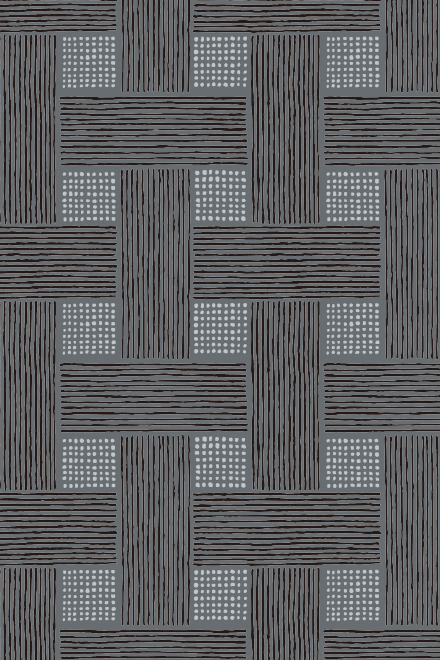
日本は国土の7割程が
山林に おおわれている
家は木造だったし
日用品も 木を細工したものが多かった
日本人にとって 木工品は
優しく 暖かく 親しみやすい
(脇阪 克二)
Woodwork (1995, by Katsuji Wakisaka)
Approximately 70% of Japan's territory is covered by forests.
Houses were made of wood, and many of the daily commodities
were also crafted from wood.
For the Japanese, wooden crafts are
gentle, warm and approachable.
| English translation by Lala Fu |
Travail du bois (1995 par Katsuji Wakisaka)
Environ 70% de la superficie du Japon
est couverte de forêts.
Les maisons ainsi que de nombreux objets
de première nécessité étaient fabriqués en bois.
Pour les Japonais, la menuiserie a un côté
doux, chaleureux et convivial.
| Traduction francaise par JB&B |
木工 (1995, 脇阪 克二)
日本約有7成的國土面積
被森林覆蓋
不僅房屋是木造
許多日用品也是由木材加工而成
對日本人來說 木工品
既溫柔 溫暖又有親近感
| 中譯 : 莊 幃婷 |
令和5年10月04日 水曜日号
“とりどり 平成26年”
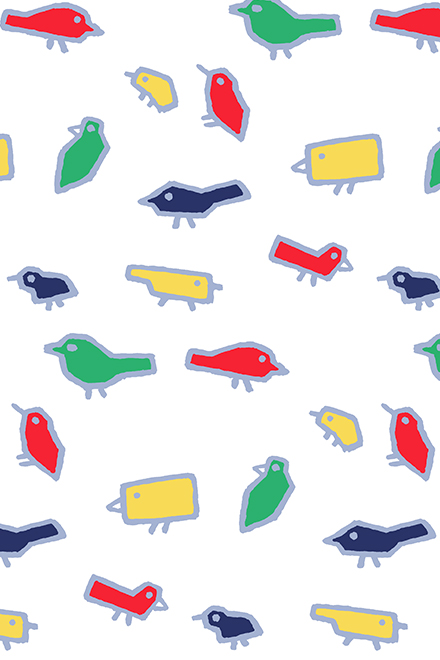
四角い鳥 丸い鳥 細長い鳥
小さい鳥など いろんな不思議な
形の鳥たちが 楽しそうにしている
みんな無心に 思い思いに
動きまわって 今を生きている
(脇阪 克二)
Colorful Birds (2014, by Katsuji Wakisaka)
Square birds, round birds, slender birds,
tiny birds. Birds in unusual shapes
seem enjoying themselves.
Innocently, spontaneously, they are hopping here and there,
living in the moment.
| English translation by Lala Fu |
Oiseaux (2014 par Katsuji Wakisaka)
Oiseaux d’apparence carrée, ronde, allongée
ou bien minuscule. Je m’amuse
de toutes ces formes insolites.
Tout ce petit monde vit
le moment présent à sa manière.
| Traduction francaise par JB&B |
彩色小鳥 (2014, 脇阪 克二)
四方形的鳥 圓形的鳥 細長型的鳥和
小小的鳥等 各種奇形怪狀的鳥
看起來非常快樂
牠們天真無邪地 隨心所欲地
自由走動 活在當下
| 中譯 : 莊 幃婷 |
令和5年09月30日 土曜日号
“おむすび 令和4年”
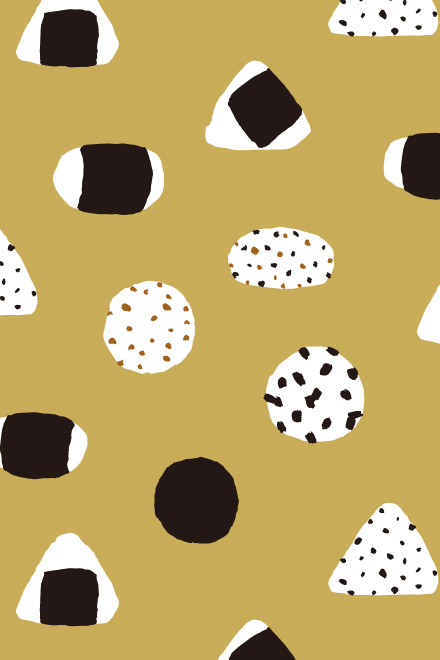
おむすびは農業の神様
「神産巣日神(かみむすびのかみ)」に由来する説
縁結びから来た説などがある
おむすびの 三角 丸 俵形は
何かに見立てられていて
それぞれ意味がある
おむすびは日本食の原点であり
日本人の心のふるさとでもある
(脇阪 克二)
Rice Balls (2022, by Katsuji Wakisaka)
Rice ball is said to be originated from the god of agriculture
"Kamimusubi-no-kami", while some said it came from the concept "enmusubi",
which means the human connections we make in our lifetime.
The triangular, round and cylindrical shapes of rice balls
were created in reminescene of something in particular,
each carries a special meaning.
Rice ball is the origin of Japanese cuisine.
It is also the home of the Japanese's hearts.
| English translation by Lala Fu |
Boulettes de riz (2022 par Katsuji Wakisaka)
Le terme musubi aurait pour origine
l’association avec le dieu de l’agriculture,
« Kamimusubi no kami » .
Les boulettes de riz triangulaires, rondes,
en forme de boule, sont inspirées par des formes définies.
Chacune a sa signification.
Les O-musubi sont à l’origine de la cuisine japonaise
et également de la spiritualité du peuple japonais.
| Traduction francaise par JB&B |
飯糰 (2022, 脇阪 克二)
Omusubi相傳源於農業之神
「神產巢日神(Kamimusubinokami)」
但也來自緣結(enmusubi)等諸多說法
飯糰有三角形、球形和圓柱形等形狀
寓意某種事物
每個都有自己的涵義
飯糰是日本飲食文化的起源
也是日本人的心靈故鄉
| 中譯 : 莊 幃婷 |
令和5年09月27日 水曜日号
“かぼちゃ 平成27年”
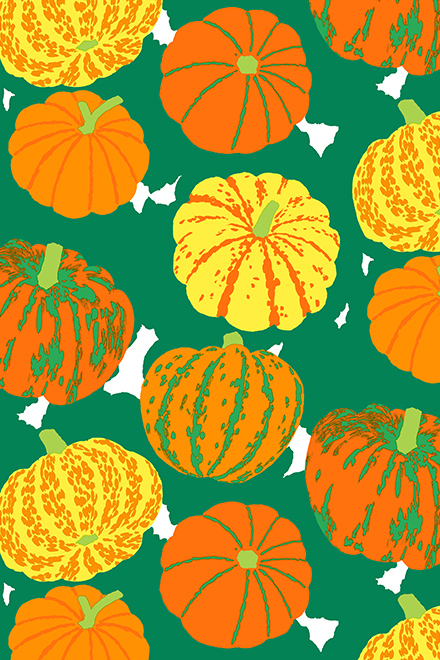
かぼちゃは秋の味覚の代表的なもののひとつ。
今はハローウィンもあるので
秋には脚光を浴びている。
こんな大きくおいしいものが
土と水と太陽・・・・で出来るというのは
何といっても不思議。
(脇阪 克二)
Pumpkins (2015, by Katsuji Wakisaka)
Pumpkin is one of the fruits that can represents the autumn delicacies.
It comes into the spotlight in autumn
because Halloween is getting more popular nowadays.
It is so amazing that these big and tasty pumpkins
can be grown only with soil, water and sun...
| English translation by Karen Yiu |
Citrouille (2015 par Katsuji Wakisaka)
La citrouille est un fruit qui représente bien l’automne.
Maintenant, il y a aussi Halloween
qui le met à l’honneur pendant cette saison.
N’avoir besoin que de la terre, de l’eau et du soleil
pour produire cette grosse chose aussi délicieuse
est quelque chose de très mystérieux.
| Traduction francaise par JB&B |
南瓜 (2015, 脇阪 克二)
南瓜是秋季的代表風味之一
加上現今萬聖節的流行
使其在秋天時備受矚目
如此大又美味的食材
只需要土壤、水、陽光就能生長
真的很不可思議
| 中譯 : 莊 幃婷 |
→こちらのテキスタイルデザイン商品
(Textile products with this pattern)
令和5年09月26日 火曜日号
“大工道具 令和5年”


これは 少し前の時代まで
ふつうに 使われていた 大工道具
電動工具が出現する前
人の力で全てが行われていた
時代のもの
鉄や木で 作られたものだが
どこか 人間的な感じがする
その時代の 人々のあり様が
こういう道具にも
表われてくるのだろう
(脇阪 克二)
Carpentry Tools (2023, by Katsuji Wakisaka)
These carpentry tools were commonly used in the early ages.
They are the tools of an era when all the work relied solely on manual labour,
before electric tools were invented.
Made of iron and wood, they nevertheless give a sense of human.
Perhaps this kind of tools is also capable of telling the lives of the people in that age.
| English translation by Lala Fu |
Outils de menuiserie (2023, par Katsuji Wakisaka)
Il y a encore quelques années,
les outils de menuiseries traditionnels étaient utilisés,
avant l’avènement des machines électriques.
Tout était créé par la force des hommes.
Instruments fabriqués de fer et de bois,
c’est d’une certaine manière le prolongement même de l’homme.
Les gens de cette époque étaient à l’image de leurs outils.
| Traduction française par JB&B |
大工道具 (2023, 脇阪 克二)
這是在較早時代一直被普遍使用的木匠工具。
它是在電動工具面世之前,完全使用人力的時代產物。
雖然由鐵和木等素材製成,但卻有一種人性化的感覺。
這種道具大概也可以表達
那個時代人們的生活光景吧。
| 中譯 : 傅 蕊雯 |
→こちらのテキスタイルデザイン商品
(Textile products with this pattern)
令和5年09月23日 土曜日号
“調べ 平成4年”
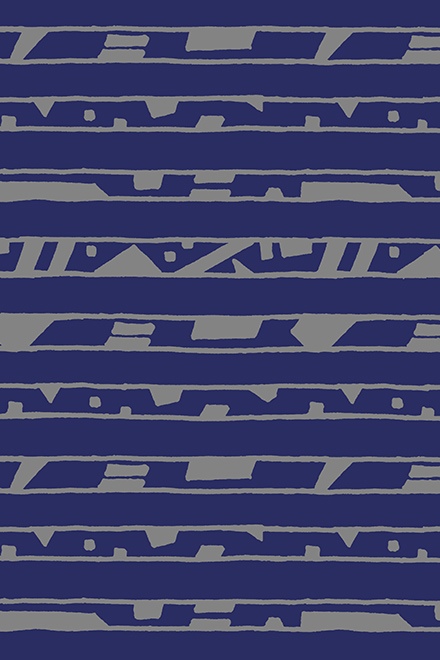
音楽は不思議なもので
全身で感じてくる
いい調べ聞くと 心も体も
気持よくなり 楽しくなってくる
この柄は音符ではないけれど
音楽が聞こえてきて
はずんでくるものがある
(脇阪 克二)
Melody (1992, by Katsuji Wakisaka)
Music is a mysterious thing
that you feel with your entire body.
When you listen to a good melody,
your heart and body feel pleasant, and you become joyful.
Although this pattern may not be music notes,
it has something that makes you hear them
and feel lively and cheerful.
| English translation by Karen Yiu |
Mélodie (1992 par Katsuji Wakisaka)
La musique est quelque chose d’étrange.
Je la sens avec tout mon corps.
Quand j’écoute une belle mélodie,
je me sens heureux et tellement bien,
dans mon coeur et dans mon être.
Bien que ce motif ne soit pas une note de musique,
un air bondit jusqu’à mes oreilles.
| Traduction francaise par JB&B |
旋律 (1992, 脇阪 克二)
音樂是個很神奇的東西
可以用全身感受
當聽到優美旋律時
身心都會感到愉快和喜悅
此圖案雖不是音符
但內裡有著讓人彷彿聽得見樂聲
湧起雀躍心情的元素
| 中譯 : 莊 幃婷 |
→こちらのテキスタイルデザイン商品
(Textile products with this pattern)
令和5年09月20日 水曜日号
“小筥 平成17年”
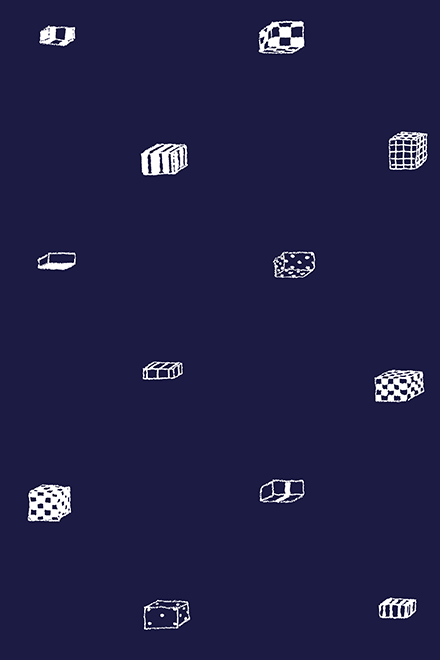
大事にしているものを
入れたくなるような小筥
小さくて素敵な贈物を入れて
そっと手渡したくなるような小筥
水玉、縞、市松などで
表面を飾った小筥
お気に入りの筥を
たくさん集めている人もいますね
(脇阪 克二)
Small Box (2005, by Katsuji Wakisaka)
A small box that makes you want to put in
something precious and important.
A small box that makes you want to put in small but wonderful gifts,
and gently hand it over to someone.
Small boxes adorned with polka dots, stripes,
or checkerboard patterns on its surface.
There are also people who love collecting
many boxes that they like.
| English translation by Karen Yiu |
Petite boîte (2005 par Katsuji Wakisaka)
Une petite boîte qui donne envie
d’y ranger ses trésors.
D’y insérer un merveilleux petit cadeau
et de la remettre à quelqu’un tout en douceur.
Qu’elle soit décorée à l’extérieur
avec des pois, des rayures,
ou bien des motifs à carreaux,
beaucoup de personnes
les collectionnent.
| Traduction francaise par JB&B |
小筥 (2005, 脇阪 克二)
將珍視的物品放入的小筥(小盒子)
可以裝入小巧精美的禮物
輕鬆送出的小筥
外表用圓點、條紋和市松格子等裝飾的小筥
也有人會大量收集喜歡的小筥呢
| 中譯 : 莊 幃婷 |
令和5年09月16日 土曜日号
“郷愁 令和4年”
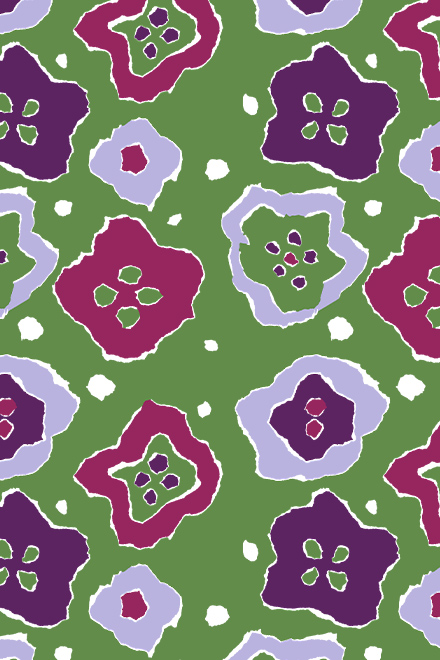
生れ育ったところを離れて
住んでいると 時々ふるさとを
なつかしいなあと思う
昔のことを なつかしくなることもある
色をぬった紙を手でちぎって
作ったので たどたどしい感じがあり
なつかしくホッとするものがある
(脇阪 克二)
Nostalgia (2022, by Katsuji Wakisaka)
When living away from the place
I was born and raised,
I find myself feeling homesick sometimes.
There are times when I become nostalgic about the past,
so I made this piece by tearing colored papers with my hands.
It has a sense of roughness
and evokes both nostalgia and a comforting sense of relief.
| English translation by Karen Yiu |
Nostalgie (2022 par Katsuji Wakisaka)
Vivant loin du lieu où j’ai grandi,
je me sens de temps en temps nostalgique.
Il y a des fois où le bon vieux temps me manque.
Déchirer à la main du papier de couleur
de façon maladroite a quelque chose
de mélancolique et réconfortant.
| Traduction francaise par JB&B |
鄉愁 (2022, 脇阪 克二)
離開了自幼生長之地生活
時常會想念起家鄉
或許也是對從前的事物感到懷念
這是將塗上顏色的紙 以手撕貼創作的作品
有點東倒西歪不工整
也有種懷舊和安心感
| 中譯 : 莊 幃婷 |
→こちらのテキスタイルデザイン商品
(Textile products with this pattern)
令和5年09月13日 水曜日号
“きのこ 平成6年”
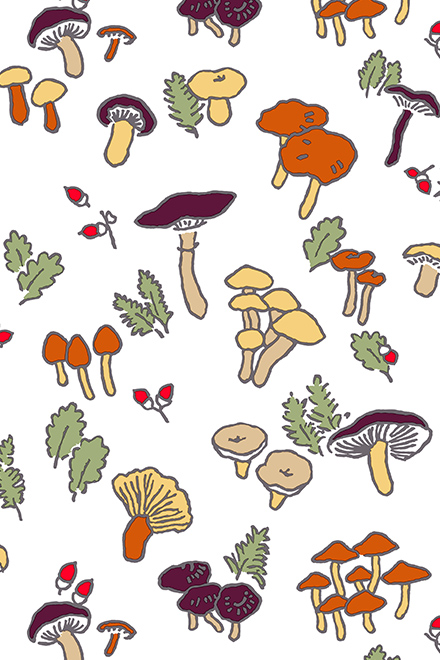
きのこは種類が多い。
まつたけ、しいたけ、なめこ、まいたけ、
えのきだけ、マッシュルーム、
まだまだある。
もともと森や山に自生しているものだが
今は栽培されているものも多い。
色も形も独特で
絵にしても個性的なので
楽しいものになった。
(脇阪 克二)
Mushrooms (1994, by Katsuji Wakisaka)
There are many types of mushrooms.
Matsutake mushrooms, shiitake mushrooms, nameko mushrooms,
maitake mushrooms, enokidake mushrooms, straw mashrooms
and many more.
They originally grow wild in forests and mountains,
but many are now cultivated.
They are unique in color and shape,
and are fun to draw
because of their individuality.
| English translation by Karen Yiu |
Champignon (1994 par Katsuji Wakisaka)
Il existe une grande variété de champignons.
Le matsutake, le shiitake, le nameko, le maitake,
le champignon enoki ou le champignon de Paris.
Et bien plus encore.
Originaires des forêts et des montagnes,
beaucoup sont cultivés par l’homme aujourd’hui.
De couleurs et de formes uniques,
même sur une image, leur originalité
est amusante.
| Traduction francaise par JB&B |
菇類 (1994, 脇阪 克二)
蕈菇的種類有很多種
松茸、香菇、鴻喜菇、舞菇、
金針菇、蘑菇
還有許多許多
原本在森林和山間自然生長
現在則是人工栽培居多
顏色和形狀都很獨特
即使繪成圖案也很有個性
成了一幅愉快的作品
| 中譯 : 莊 幃婷 |
→こちらのテキスタイルデザイン商品
(Textile products with this pattern)
令和5年09月09日 土曜日号
“坪庭 平成20年”
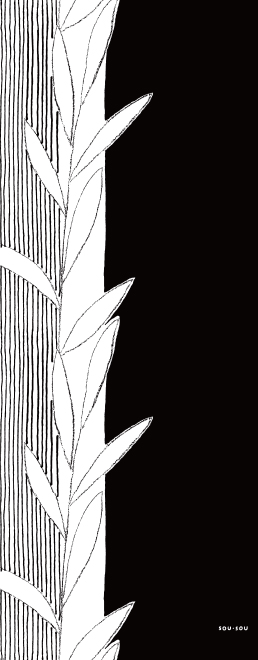
屋敷内の建物と建物の間の小さな空間に
少しの植物で自然の趣(おもむき)を表そうとした坪庭。
この模様も縞と縞の間にひとつの植物を組み合わせることで、
情緒あるものにしたかった。
(脇阪 克二)
Spot Garden (2008, by Katsuji Wakisaka)
The spot garden (tsuboniwa) is a small space between buildings inside the estate,
where a few plants were used to express a natural atmosphere.
This pattern aimed to combine one plant between the stripes
to create an emotional effect.
| English translation by Karen Yiu |
Jardin intérieur (2008 par Katsuji Wakisaka)
Quelques plantes cultivées entre les bâtiments d’une résidence
donne un petit jardin reflétant la beauté de la nature.
Je voulais faire ressortir cette émotion dans ce motif
en combinant végétal et rayures.
| Traduction francaise par JB&B |
坪庭 (2008, 脇阪 克二)
坪庭是在房屋的建地內,運用建築之間的小小空間種植一些植物
以此表現自然之趣的庭園設計
我也想透過在條紋間加入一種植物的組合,創造充滿獨特趣味的圖案
| 中譯 : 莊 幃婷 |






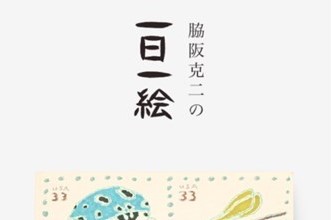
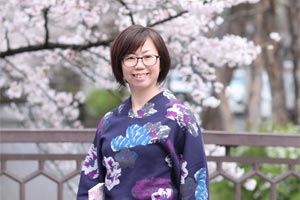
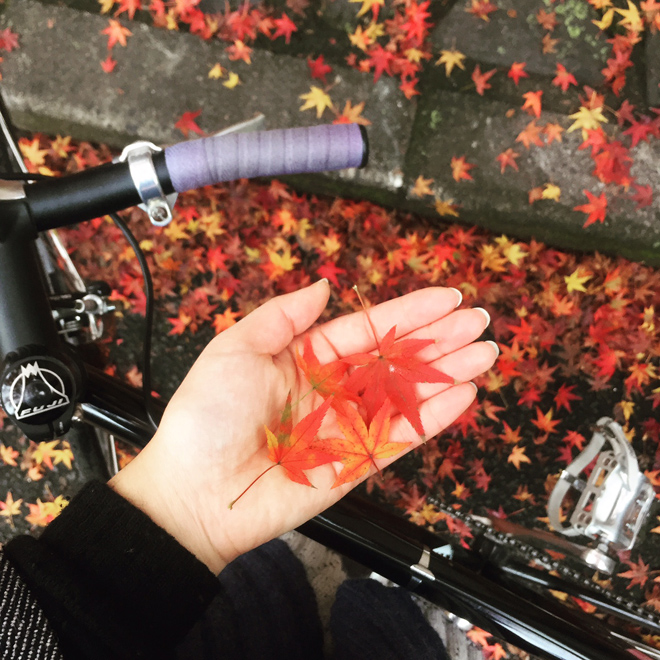
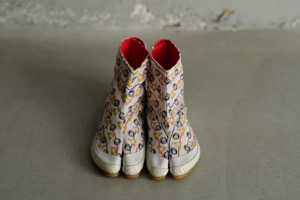
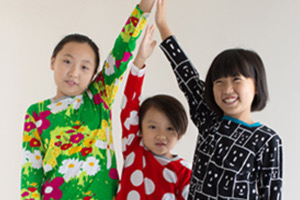
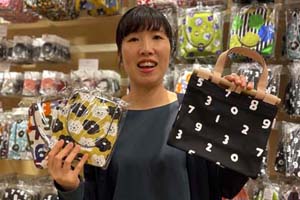

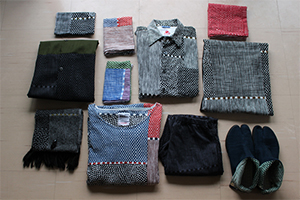
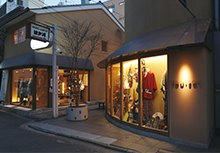
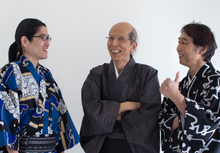

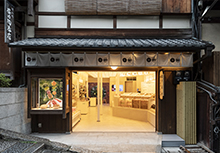

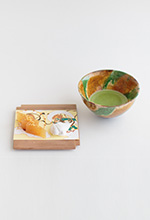
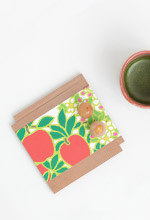
 お問い合わせ窓口
お問い合わせ窓口